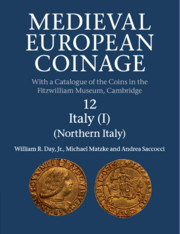Book contents
- Frontmatter
- Dedication
- Contents
- List of plates
- List of figures
- List of maps
- List of tables
- Preface
- Nomenclature
- List of abbreviations
- 1 GENERAL INTRODUCTION
- 2 ROYAL AND IMPERIAL COINAGES
- 3 PIEDMONT
- 4 LIGURIA
- 5 LOMBRDAY
- 6 veneto
- APPENDICES
- 1 Coin hoards and single-finds
- 2 Heraldry, saints, symbols
- 3 Metrology and compositional analyses
- 4 Glossary: coin names,weights and numismatic terms
- Bibliography
- SALE CATALOGUES
- CATALOGUE
- INDEXES
3 - Metrology and compositional analyses
from APPENDICES
Published online by Cambridge University Press: 11 May 2017
- Frontmatter
- Dedication
- Contents
- List of plates
- List of figures
- List of maps
- List of tables
- Preface
- Nomenclature
- List of abbreviations
- 1 GENERAL INTRODUCTION
- 2 ROYAL AND IMPERIAL COINAGES
- 3 PIEDMONT
- 4 LIGURIA
- 5 LOMBRDAY
- 6 veneto
- APPENDICES
- 1 Coin hoards and single-finds
- 2 Heraldry, saints, symbols
- 3 Metrology and compositional analyses
- 4 Glossary: coin names,weights and numismatic terms
- Bibliography
- SALE CATALOGUES
- CATALOGUE
- INDEXES
Summary
METROLOGY
The various weight systems in use in medieval northern Italy, as elsewhere in medieval Europe, went back to the Roman system. The Roman pound is traditionally taken as 327.45g, the figure proposed by Bockh (1838) and followed by, among others, Hultsch (1882). Scholars have since put forward figures varying from 322.56g (Naville 1951, 108–9) to c. 330g, but none has won general acceptance and all imply a greater degree of precision than is justified or even possible, given the nature of the evidence. It therefore seems best to retain the figure on which so many calculations have been based and which, if more precise than the evidence warrants, cannot be far wrong. The Roman pound consisted of twelve ounces (unciae) of 27.29g each, which consisted of twenty-four scruples (scrupula) of 1.14g each, which in turn were made up of twenty-four grains (grani) of 0.047g each. There were other intermediate units in the Roman system, e.g. the drachm (drachma,3.41g) of three scrupula and the carat-weight (siliqua, 0.189g) of four grains that sometimes gained currency in medieval north Italian systems, but the principal components of the various systems were the pound or libra, mark or marca (see below), ounce or oncia, scruple/pennyweight or denaro (dwt), and grain or grano, generally (but not always) in the same relationship, which may be expressed as shown in Table 60.
From the fall of the empire, however, the Roman system everywhere underwent independent development so that before long local systems were no longer identical with it. The absolute sizes of the units changed. In some places, there were also modifications in the structure of the system. This sometimes involved the introduction of altogether new weights such as the mark, a Germanic weight unit equal to eight ounces and thus two-thirds of the pound. In medieval Western Europe, the marks of Cologne (233.85g) and Troyes (244.75g) were particularly important and widely used. In northern Italy, the mark became the principal unit of weight for coinage and precious metals in Venice, Milan and Genoa, though in the last city it consisted of nine ounces of 26.40g each (i.e. 237.56g) instead of eight.
- Type
- Chapter
- Information
- Medieval European Coinage , pp. 720 - 728Publisher: Cambridge University PressPrint publication year: 2016

